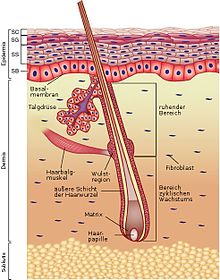Hair follicle
![]()
This article is about the hair of mammals. There are further a number of hair-like structures: for plant hair, see trichome; for hair-like structure in arthropods, see seta (zoology); for that in annelids, see chaeta; for adhesive hairs on the feet of geckos, see spatula, for hair-like sensory organ in arthropods and some reptiles, see sensillum, for cilia on cells, see cilia (especially kinocilia), for hair-like processes on sensory cells (hair cells), see stereocilia. For other meanings, see Hair (disambiguation).
![]()
Haare is a redirect to this article. For the deserted village of the same name in Saxony-Anhalt see Haare (Wüstung).
A hair (Latin pilus, capillus [principal hair], crinis, coma) is a long horny thread that grows on the skin of mammals. Hair is composed essentially of keratin. All mammals bear at least partial hair on their skin; mucous membranes are always hairless. With a few exceptions (palms, insides of fingers, soles of feet, nipples, red of lips), the entire outer skin of humans is hairy. In human hairiness (also hair as a collective), a distinction is made between head hair (main hair, beard hair and eyebrows) and body hair.

Schematic cross section through the skin with hair follicle.

A human hair under the microscope (image detail: 0.6×0.4 millimetres)
Etymology
The term Middle High German, Old High German hār, "hair," also said of animal fur, goes back to Germ. *hēra- "hair", which belongs to the idg. root k̑er[s] "to stare; to be rough, shaggy".
Animal hair / fur
Hairiness is the characteristic body covering of all mammal species and is usually referred to as fur or pelt (with skin: bellows). In some species or in certain life stages and body regions, however, hardly any hair is formed. In animals, a distinction is made between fur hairs (capilli, as guard and awn hairs), bristle hairs (setae), wool hairs (pili lanei), and long hairs. In addition, many mammals have vibrissae (tactile hairs). In addition, horny hairs that have developed further occur as spines (e.g. in hedgehogs).
Questions and Answers
Q: What is a hair follicle?
A: A hair follicle is a part of the skin responsible for growing hair by packing old cells together.
Q: Where are sebaceous glands found in the skin?
A: Sebaceous glands are tiny sebum-producing glands found in almost all skin, except on the palms, lips, and soles of the feet.
Q: What is the role of sebaceous glands in relation to hair growth?
A: The number of sebaceous glands attached to a hair follicle increases with the thickness of the hair.
Q: What is the arrector pili?
A: The arrector pili is a tiny bundle of muscle fiber responsible for causing the follicle to become more upright and stick up slightly above the nearby skin, leading to goosebumps or goose flesh.
Q: What is the role of stem cells in hair production?
A: Stem cells located at the junction of the arrector and the follicle are primarily responsible for ongoing hair production during the Anagen stage.
Q: What is the average growth rate of healthy hair follicles on the scalp?
A: The average growth rate of healthy hair follicles on the scalp is nearly 0.5 inches (13mm) per month.
Q: Where are sebaceous glands not found in the skin?
A: Sebaceous glands are not found on the palms, lips, and soles of the feet.
Search within the encyclopedia